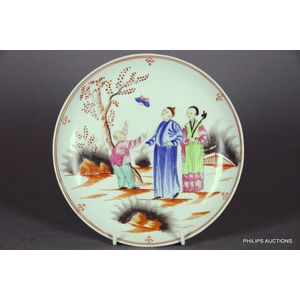Mandarin Bird Saucer, 1810
A New Hall saucer dish, circa 1810, pattern 421 decorated in a Mandarin palette with 'Bird and the Butterfly' pattern pattern number underside and reverse '7' decorator's mark Diameter 20 cm
You must be a subscriber, and be logged in to view price and dealer details.
Subscribe Now to view actual auction price for this item
When you subscribe, you have the option of setting the currency in which to display prices to $Au, $US, $NZ or Stg.
This item has been sold, and the description, image and price are for reference purposes only.
- Mandarin Palette - The Mandarin palette is a decorative style used to decorate Chinese export porcelain, which was produced in China specifically for export to Europe and other parts of the world from the 16th to the 19th century. The Mandarin palette is characterized by a bright and colourful design featuring various figures, landscapes, and ornamental motifs.
The Mandarin palette was first used during the reign of the Kangxi Emperor (1662-1722) in the Qing dynasty. It was named after the Mandarin officials who were depicted in the designs, wearing their distinctive robes and hats. The palette was popular among European collectors and was often used to decorate tea services, vases, and other decorative objects.
The Mandarin palette was made up of a limited number of colours, typically blue, green, pink, and gold. The designs often featured figures in a garden setting, surrounded by trees, rocks, and pavilions. Some of the most popular motifs included dragons, birds, flowers, and auspicious symbols, such as bats and peaches.
The Mandarin palette remained popular throughout the Qing dynasty and was used to decorate a wide range of Chinese export porcelain. It continued to be popular among European collectors into the 19th century, and its influence can be seen in the work of many European ceramic artists of the time. - Circa - A Latin term meaning 'about', often used in the antique trade to give an approximate date for the piece, usually considered to be five years on either side of the circa year. Thus, circa 1900 means the piece was made about 1900, probably between 1895 and 1905. The expression is sometimes abbreviated to c.1900.
This item has been included into following indexes:
Visually similar items

Spode dish hand painted 1833-1847? approx 14 cm diameter
Sold by
in
for
You can display prices in $Au, $US, $NZ or Stg.

A New Hall plate, circa 1810, pattern 375, the brightly decorated plate in 'Tobacco Leaf' pattern in orange, green and cobalt colours upon a white ground surrounded by husk border, pattern number underside Diameter 21.5 cm
Sold by
in
for
You can display prices in $Au, $US, $NZ or Stg.

Early Capodimonte side plate with armorial
Sold by
in
for
You can display prices in $Au, $US, $NZ or Stg.

Japanese Imari charger, c.1800 A/F
Sold by
in
for
You can display prices in $Au, $US, $NZ or Stg.
